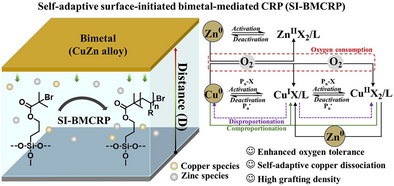Highly Oxygen-Tolerant and Self-Adaptive Surface-Initiated Bimetal-Mediated Controlled Radical Polymerization
Graphical Abstract
We report a novel and versatile self-adaptive surface-initiated bimetal-mediated controlled radical polymerization strategy for the fabrication of multifunctional polymer brushes under ambient conditions with exceptional oxygen tolerance. By introducing a bimetal CuZn alloy, the system self-adaptively regulates the dissociation of copper species, ensuring robust and controllable polymer brush growth across a wide range of distances between the bimetallic alloy and the initiator-modified substrate.
Abstract
We report herein a self-adaptive surface-initiated bimetal-mediated controlled radical polymerization (SI-BMCRP) for fabricating various polymer brushes using microliter volumes under ambient conditions. The introduction of bimetal CuZn alloy can self-adaptively control the dissociation of copper species while still realizing the controllability of polymer brush growth with high oxygen tolerance at a wide range of distances between the bimetal alloy and the initiator-modified substrate. The successful fabrication of multiscale and multifunctional polymer brushes with high-end group fidelity and patterned architectures further demonstrates the robust nature of SI-BMCRP. The resultant polymer brushes show great potential for new applications in moisture-enabled electricity generation, breath monitoring, and speech recognition.
Conflict of Interests
The authors declare no conflict of interest.
Open Research
Data Availability Statement
The data that support the findings of this study are available in the supplementary material of this article.





